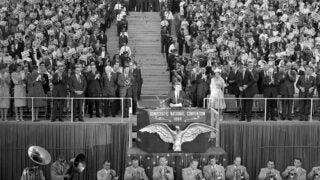USC’s Enrique Martínez Celaya Explores the Ties Between Art, Science and Philosophy
The physicist turned artist crosses disciplines — and time periods — with his work.
As an artist and writer with an advanced degree in physics, Enrique Martínez Celaya has a background befitting a modern Renaissance person. Finding his passion has been a lifelong pursuit, but the USC Provost Professor of Humanities and Arts has expanded the possibilities of his work rather than narrowing them down. Taking the unconventional path is increasingly a reflection of our era, he says.
“We live in a very complex time, and the complexity requires engagement not only across disciplines but in some ways across time. Boundaries are artificial.”
Born in Cuba, Martínez Celaya grew up equally interested in art, science and philosophy. When it came time to choose, he opted for applied and engineering physics at Cornell University, then a master’s in quantum electronics from the University of California, Berkeley. His epiphany came when he pursued a doctoral degree while also enrolling in an MFA program at the University of California, Santa Barbara.
He had invested so much time and energy into physics research, and science fascinated him. But he pictured how his life looked as a researcher, and it sparked no excitement. Instead, something nagged at him. “As I got older, I felt the urgency of other questions about all the things that I’m working on now—the relationship between being and self to the past,” Martínez Celaya says.
He dropped out of the doctoral program to focus on his MFA, and also studied at the Skowhegan School of Painting and Sculpture in Maine.
Though the artist and writer left his scientific study behind, he never lost his interest in it. Instead, he folds elements of it into his art, which also incorporates other disciplines such as psychology, economics and philosophy.
Martínez Celaya says his work is not necessarily in dialogue with his contemporaries, but with figures spanning centuries, such as Leonardo da Vinci, Diego Velázquez and Herman Melville, to name a few. The professor, who has joint appointments at the USC Dornsife College of Letters, Arts and Sciences and the USC Roski School of Art and Design, brought this perspective to his recent course on understanding modernism, where students studied poets and painters from the fringes of the movement.
“At university, the tendency is to keep everything at an arm’s distance away, but I want to remind students these things are alive and meant a world to the people who made them,” he says. “By seeing the life present in a work, it can speak to them today.”
Martínez Celaya also regularly presents public lectures featuring prominent figures, invites children to participate in art activities, and offers internships, grants and apprenticeships for young scholars who are finding their path.
As someone who has taken his own unusual path, Martínez Celaya can relate to the pressure and sacrifice that comes with choosing a career and identity.
“Many students leave possibilities of real happiness behind with these choices,” he says. “But education should be an opportunity to explore these passions, not extinguish them.”



